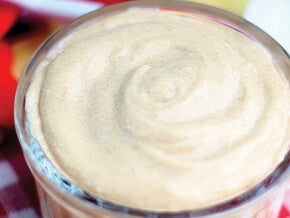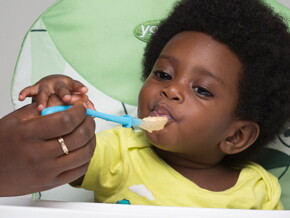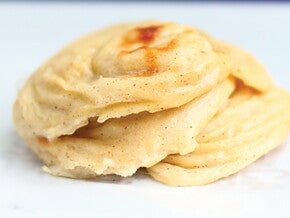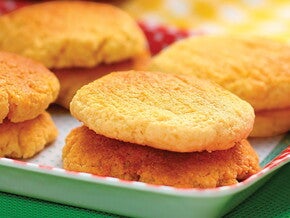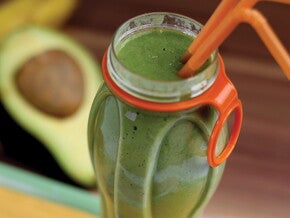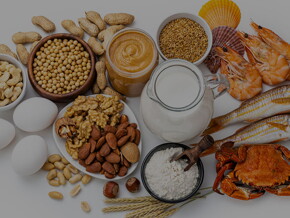
Watch for these solid food signals:
- The ability to support her head and neck.
- The strength to sit without support.
- An interest in what you’re eating.
- She seems hungrier than usual.
- Keeps food in her mouth without using her tongue to push it out.
If you aren't sure whether your baby is ready to start on solid foods, talk to your healthcare professional. These indicators mean it may be time to complement (yes, complement—not substitute) breast milk with solid foods.
Before your baby makes her own mealtime history, count up these 10 things that can help make the transition to solid foods easier for everyone!
1. A single ingredient start
Make your baby’s first food a single-ingredient, iron-rich food, like meat, meat alternatives or an iron-fortified baby cereal (Remember, the iron stored in your baby’s body starts to deplete around 6 months). After you go iron-rich, and as long as these foods are your focus, there’s no set order on types of foods you should introduce.
2. Morning glory
Wake up her taste buds! Yes, morning is the best time to introduce new foods, since your baby is likely hungry and happy (Plus, you’ll have the full day to monitor for food intolerances or allergic reactions).
3. Small amounts
Start with 1 tablespoon of food—that’s all she needs for the first go-round.
4. Texture
Her first foods should be smooth in consistency and free of lumps.
Instructions for first feedings with baby cereal: For instant or ready to eat cereals, place one tablespoon of cereal into a bowl and mix with three or four tablespoons of previously boiled, lukewarm water. Mix in enough water to make a runny mixture.
5. Temperature
Prepare lukewarm or room temperature foods (Too cold = Less enjoyable. Too hot = unsafe).
6. Spoon it!
Dip the tip of a soft slim spoon into the food and place it up to your baby’s mouth (If she doesn’t want it, don’t force it, she’ll come around with a little patience).
Make mealtime fun: “Yay! Good job!” Tell her how well she did with her new food.
7. Wait for a reaction
What did she do with her food—did it stay in or come back out? (It might be days before any food makes it to her tummy, eating food is a new skill after all).
8. Wait for the signal
“More, darling?” Make sure that your baby is looking for more and avoid pushing food into her mouth before she’s ready.
9. Discard the remaining food
It’s important to throw out any leftovers once you’ve heated food or dipped baby’s spoon into it (Babies are more sensitive than adults when it comes to bacteria that can grow in food).
10. 2-day trial
Keep offering a new food for at least 2 days before trying another food. This delay is important should your baby have an adverse reaction, so you’ll have a better idea what food caused the reaction. If this happens, stop feeding the food right away and talk to your healthcare professional.
Health experts advise not to delay the introduction of any specific solid food beyond 6 months of age, regardless of family history of allergy.2 You can introduce peanuts, soy, whole eggs, fish and wheat as you would any other food and monitor for allergic reactions—just talk to your healthcare professional if you have any concerns.
Food for thought: Always use a spoon, never a bottle, when feeding solids.
What to avoid
Here’s where you have to contain your excitement, because not all foods are appropriate for your little one—including this list of items to keep off the menu in the early stages of food.
Whole cow’s milk
Whole cow's milk is a poor source of iron, so should be avoided until your baby is at least 9-12 months old. It could also displace other iron-rich foods (increasing the risk of iron deficiency).
Honey
Do not feed honey (pasteurized or unpasteurized) to infants under 1 year of age. Honey, including pasteurized, may cause a type of food poisoning called infant botulism, and should not be added to any baby food. Honey is only safe to introduce once your baby is 1 year old.
Sugar & salt
Adding sugar and salt will prevent your little one from fully experiencing new foods, and developing a taste for the food’s natural flavours. Be mindful to prepare foods with little or no added salt and sugar.
Raw & unpasteurized beverages
Babies and toddlers should not consume raw or unpasteurized beverages. Pasteurization is an important step that eliminates harmful bacteria. Unpasteurized beverages, such as some types of apple cider, can be harmful to babies and toddlers. Read the label when choosing drinks for your little one.
A day in your baby’s diet Meal-planning for yourself isn’t always easy, but what about for your baby? Well, this is only a guide, but hopefully this sample of what your baby could be eating can help simplify things. Guide or no guide, it’s important to follow your baby’s hunger and fullness cues and introduce her to new foods one at a time.
Here’s a typical meal plan for infants 6-9 months of age who are accustomed to eating solid foods1.
- Waking up with baby
- Breast milk
- Breakfast
- Breast milk
- 2-4 tbsp iron-fortified infant cereal
- 2-3 tbsp puréed or mashed fruit
- Mid-morning snack
- Breast milk
- Lunch
- Breast milk
- 1-3 tbsp meat or alternative
- 2-3 tbsp puréed or mashed fruit
- 2-3 tbsp puréed cooked vegetables
- Dinner
- Breast milk
- 2-4 tbsp iron-fortified infant cereal
- 2-3 tbsp puréed, cooked vegetables
- 2-3 tbsp puréed or mashed fruit
- Before going to bed
- Breast milk
- Breast milk
1. Chan ES, Cummings C. Dietary exposures an allergy prevention in high-risk infants. Paediatr Child Health 2013;18(10):545-9.
